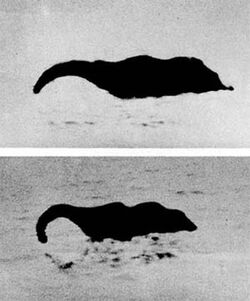The Morgawr (meaning sea giant in Cornish) is a cryptid found in Falmouth Bay, in the United Kingdom.
Description[]
There are two major appearances that are used to describe to Morgawr.
The first of these descriptions says that the Morgawr is a very large crocodile, over 60 feet long, with webbed feet. This is stated in folklorist Malcolm Archibold's novel Sixpence for the Wind: A Knot of Nautical Folklore, but has yet to be corroborated by any hard evidence.
The other description is a bit more modern. The Mogawr is described as being a long sea serpent, with brown skin akin to a sea lion. Local fishermen frequently denounce these sightings as identification of other animals.
History[]

John Holmes' video.
The first reported sighting occurred in the early 1910's. According to local folk tales, a German submarine struck a British merchant ship, sinking it. The commotion caused Mogawr to investigate, thus scaring the German navy away. According to George Eberhart's Mysterious Creatures: A Guide to Cryptozoology, American sailors also saw a similar creature during the same time period.

Tony Shiels' hoax (right).
A new wave of sightings would happen 60 years later, in 1975. According to Tony Deane's and Tony Shaw's Folklore of Cornwall, a small packet of fishermen witnessed the monster, but many of them brushed it off. In February of 1976, a local resident known only as Mary F published two photographs which reportedly show the monster. George Vinnicombe and Jack Cock, two fishermen, also published their encounter with the beast in July of that same year. Tony Rogers and John Chambers, two Londoners visiting the area, claimed to see a pair of sea serpents in the Falmouth waters. In the 1980's, famous conservationist Sir Peter Scott led an expedition into Cornwall in an attempt to study the creature. In July 1985, respected writer Sheila Bird witnessed a gray sea serpent whilst walking along the coast. Through the five years between 1995 and 2000, there was also a large increase in the number of sightings. In 1999, John Holmes managed to capture video of what he claims to be the legendary creature.
The Morgawr is often ridiculed thanks to the work of Tony Shiels. After the initial wave of sightings, Shiels launched an investigation in 1976. He spotted the creature and even coined the name morgawr. Shiels even claims to have photographed the monster, and sent the image to the Daily Mirror newspaper, where it was published in an article about the Loch Ness Monster. Nevertheless, Shiels' responsibility for creating new cryptids, as with the Owlman, did not bring very much positive attention to the new myth.
Despite the criticism, Morgawr sightings are common and still occur today.
Sources Cited[]
- Folklore of Cornwall by Tony Deane and Tony Shaw
- Mysterious Creatures: A Guide to Cryptozoology by George M. Eberhart
- Sixpence for the Wind: A Knot of Nautical Folklore by Malcolm Archibald
